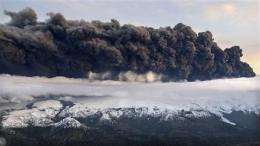Volcanic ash affects airplanes, weather, sunsets

(AP) -- In 1989, all four engines of a Boeing 747 over Alaska conked out after it flew into a cloud of volcanic ash. The crew was able to restart them, but incidents like that dramatize why hundreds of flights every year are diverted around such gritty debris.
A volcano can blow immense amounts of material into the sky, making the weather cooler and producing spectacular red and orange sunsets. But Thursday's disruption of air travel underlines what airborne ash can mean for jetliners.
Such a huge effect on airline schedules is unusual, because ash plumes usually appear well away from the most crowded airspaces. This week's eruption in Iceland blew debris over Northern Europe, threatening most routes from the East Coast to Europe.
Volcanic ash can stay aloft for days and travel far. Of the more than 20 aircraft damaged by ash from the 1991 eruption of Mount Pinatubo in the Philippines, most were flying more than 600 miles from the volcano.
The tiny particles are invisible to the weather radar on airplanes and cannot be seen at night. So volcano monitoring is serious business in the United States.
"Once we detect an eruption, our first call goes to the FAA," said Tom Murray, director of the U.S. Geological Survey's Volcano Science Center, which oversees five volcano observatories nationwide. USGS scientists work closely with Federal Aviation Administration and the National Weather Service to track ash plumes.
The abrasive ash can sandblast a jet's windshield, block fuel nozzles, contaminate the oil system and electronics and plug the tubes that sense airspeed. But the most immediate danger is to the engines.
"Jet engines are like giant vacuum cleaners. If they're in a volcanic ash cloud, they're just sucking in all that ash and that damages the engines," Murray said.
The most immediate hazard occurs after ash melts or vaporizes in the extreme heat of the engine's combustion chamber, said Michael Fabian of Embry Riddle Aeronautical University's campus in Prescott, Ariz.
The melted ash can then congeal on the blades of the engine's turbine "like spray paint," he said. The deposits can block the normal flow of air through the engine, causing engines to lose thrust or shut down.
What's more, he said, the deposits can coat the fuel system's temperature sensors, fooling them into thinking the engine is running cooler than it is. So the system pours in more fuel, raising the heat and damaging the turbine, which can also make the engine shut down.
The effects can be harrowing. In the 1989 incident, the 747 dropped more than two miles in five minutes as the crew struggled to restart the engines. The 231 passengers could smell the volcanic sulfur of ash that had come from the Redoubt volcano, 150 miles away. Eventually, all the engines were restarted and the plane landed safely at Anchorage. All four engines had to be replaced.
Ash from the Mount Pinatubo eruption in the Philippines drifted more than 5,000 miles to the east coast of Africa. The eruption shot a column of ash and smoke more than 19 miles high, containing enough matter to qualify as perhaps the biggest eruption of the 20th century. The heavy fall of ash left about 100,000 people homeless and forced thousands more to flee.
The effects of that ash were even more widespread. Average world temperature dropped by more than 1 degree over the following two years, an effect seen by many scientists as a counterbalance to global warming.
The weather effect was much bigger for the 1815 eruption of Tambora in Indonesia, often called the biggest eruption in recorded history. The following year was called "the year without summer," with sporadic snowfall and killing frosts in June through August in New England and Europe. Crops failed and soup kitchens opened to feed the hungry.
Ash from the eruption of the Krakatau (sometimes called the Krakatoa) volcano between Java and Sumatra in 1883 darkened the surrounding area for two days. It drifted around the Earth several times, making for brilliant sunsets that live on today, in sketches done in England by artist William Ashcroft.
More information:
Volcano information: http://www.volcano.si.edu
Volcano alerts: http://volcanoes.usgs.gov
©2010 The Associated Press. All rights reserved. This material may not be published, broadcast, rewritten or redistributed.



















